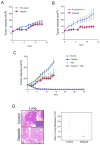PARP-1 inhibition as a targeted strategy to treat Ewing's sarcoma
- PMID: 22287547
- PMCID: PMC3319786
- DOI: 10.1158/0008-5472.CAN-11-3648
PARP-1 inhibition as a targeted strategy to treat Ewing's sarcoma
Abstract
Ewing's sarcoma family of tumors (ESFT) refers to aggressive malignancies which frequently harbor characteristic EWS-FLI1 or EWS-ERG genomic fusions. Here, we report that these fusion products interact with the DNA damage response protein and transcriptional coregulator PARP-1. ESFT cells, primary tumor xenografts, and tumor metastases were all highly sensitive to PARP1 inhibition. Addition of a PARP1 inhibitor to the second-line chemotherapeutic agent temozolamide resulted in complete responses of all treated tumors in an EWS-FLI1-driven mouse xenograft model of ESFT. Mechanistic investigations revealed that DNA damage induced by expression of EWS-FLI1 or EWS-ERG fusion genes was potentiated by PARP1 inhibition in ESFT cell lines. Notably, EWS-FLI1 fusion genes acted in a positive feedback loop to maintain the expression of PARP1, which was required for EWS-FLI-mediated transcription, thereby enforcing oncogene-dependent sensitivity to PARP-1 inhibition. Together, our findings offer a strong preclinical rationale to target the EWS-FLI1:PARP1 intersection as a therapeutic strategy to improve the treatment of ESFTs.
©2012 AACR.
Conflict of interest statement
The authors declare no competing financial interests.
Figures




References
-
- Burchill SA. Ewing's sarcoma: diagnostic, prognostic, and therapeutic implications of molecular abnormalities. J Clin Pathol. 2003;56:96–102. Available from: http://www.ncbi.nlm.nih.gov/pubmed/12560386. - PMC - PubMed
-
- de Alava E, Kawai A, Healey JH, et al. EWS-FLI1 fusion transcript structure is an independent determinant of prognosis in Ewing's sarcoma. J Clin Oncol. 1998;16:1248–55. Available from: http://www.ncbi.nlm.nih.gov/pubmed/9552022. - PubMed
-
- Brenner JC, Chinnaiyan AM. Translocations in epithelial cancers. Biochim Biophys Acta. 2009;1796:201–15. Available from: http://www.ncbi.nlm.nih.gov/pmc/articles/PMC2752494/?tool=pubmed. - PMC - PubMed
-
- Tomlins SA, Laxman B, Dhanasekaran SM, et al. Distinct classes of chromosomal rearrangements create oncogenic ETS gene fusions in prostate cancer. Nature. 2007;448:595–9. Available from: http://www.ncbi.nlm.nih.gov/pubmed/17671502. - PubMed
-
- Pinkerton CR, Bataillard A, Guillo S, Oberlin O, Fervers B, Philip T. Treatment strategies for metastatic Ewing's sarcoma. Eur J Cancer. 2001;37:1338–44. Available from: http://www.ncbi.nlm.nih.gov/pubmed/11435062. - PubMed
Publication types
MeSH terms
Substances
Grants and funding
LinkOut - more resources
Full Text Sources
Other Literature Sources
Medical
Miscellaneous

